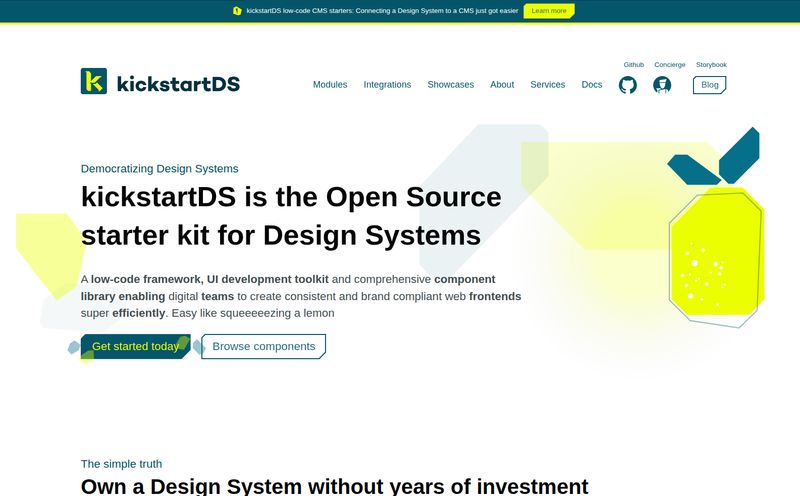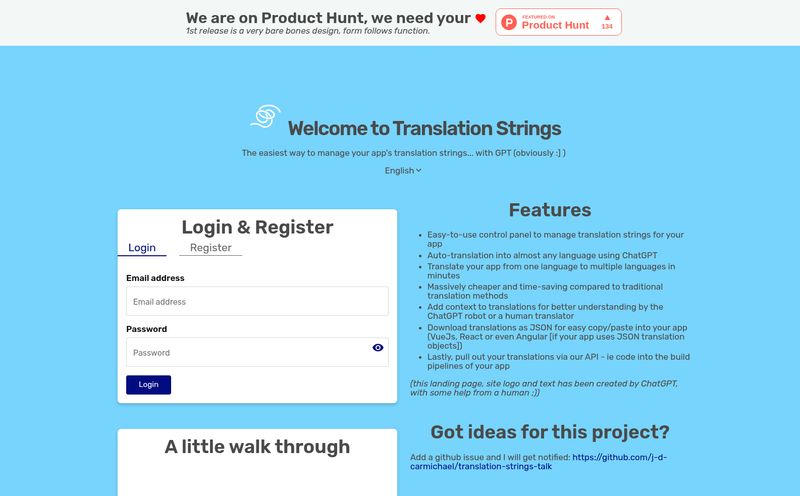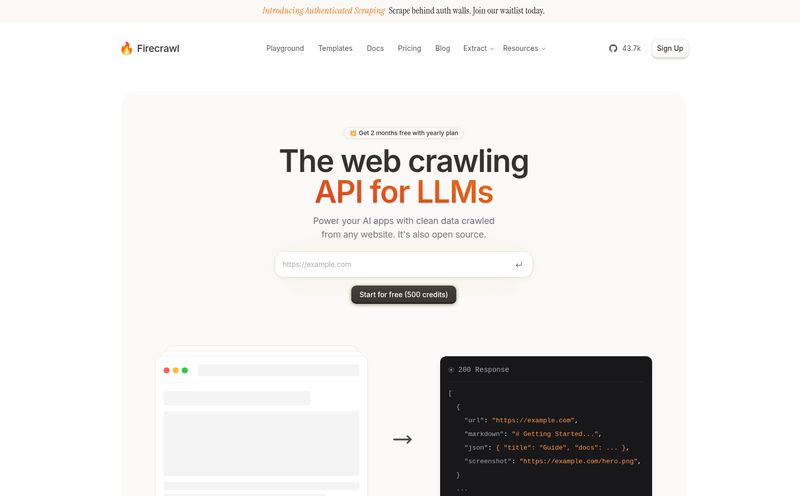It’s a classic problem, isn't it? You've poured hundreds of hours into a killer feature for your last company, or maybe you built a complex backend system for a freelance client. You have the skills. You did the work. But when it comes time to prove it... you can't. Your best work is locked behind non-disclosure agreements and private repos.
So you’re left describing your accomplishments in a bulleted list on your resume. “Engineered a scalable microservice architecture,” you write, hoping it sounds impressive. But it feels hollow. It’s like a chef describing a magnificent dish instead of letting you taste it. For years, I've manually created sanitized “demo” versions of my projects, a process that involves hours of painstaking find-and-replace, and I always live with the low-grade fear that I missed an API key somewhere. It's a drag.
Then a tool with a quirky cat-in-a-box logo called GitCase popped up on my radar. It claims to solve this exact problem using AI to transform your code, making it safe to show off. A bodyguard for your code? An intriguing idea. So, I decided to take it for a spin.
What is GitCase, Really?
At its core, GitCase is a developer portfolio builder with a very specific superpower: secure code transformation. Instead of just linking to a live project, it allows you to present the actual source code in a way that’s safe for public viewing. It’s designed to be the bridge over the troubled water of NDAs and proprietary information.
Think of it as a smart, automated black marker. It reads your code and, using AI, intelligently obfuscates the sensitive bits—API keys, database credentials, proprietary business logic, you name it. The goal is to preserve the structure, the complexity, and the context of your work, so a hiring manager or potential client can see how you think, without you giving away the keys to the kingdom.

Visit GitCase
The Magic Wand of AI Code Transformation
The term “AI-powered” gets thrown around so much it’s almost lost all meaning. I was skeptical. How good could it be? In my experience, it’s surprisingly slick. The idea is that the AI has been trained to recognize common patterns for secrets and sensitive data within codebases. It's not just doing a simple search for the word `PASSWORD`.
It understands the syntax and structure of different languages, allowing it to, for example, replace a specific algorithm with a descriptive placeholder like `// Proprietary user-matching algorithm securely transformed by GitCase`. This is so much better than just deleting the block of code. It tells the viewer what was there and proves you can handle sensitive logic. Honestly, the thought of an AI handling this tedious sanitization process is a massive weight off my shoulders. It's one of those 'why didn't this exist sooner' kind of things.
My Experience Getting Started with GitCase
The whole process is built around a platform most of us live on anyway: GitHub. There’s no clunky file upload system. You sign in with your GitHub account, grant it access to the repository you want to showcase, and you’re off to the races. This reliance on GitHub is a double-edged sword, I suppose. If you're one of the few developers using something else like GitLab or Bitbucket exclusively, you’re out of luck for now. For the other 99% of us, its a smooth starting point.
The Good Stuff I Found
The primary benefit is obvious: the peace of mind. Being able to share a direct link to a codebase and say “Here, look at my work” without a 30-minute disclaimer is fantastic. But a few other things stood out to me. The pricing model is one. We'll get into the specifics in a bit, but there are no monthly subscriptions. In an age of subscription fatigue, I find this incredibly refreshing. You just buy credits and use them when you need to transform a project. Perfect for someone like me who might only update their portfolio a few times a year. There’s also a free tier, so you can poke around and see if it works for you without pulling out your credit card.
A Few Things to Keep in Mind
Now, it’s not all sunshine and rainbows. Let's talk about the credits. This is the part that requires a little bit of thinking. You pay for credits, and every action has a cost. Starting a new project, for instance, costs 100 credits. The actual transformation cost then depends on the size and complexity of your code. It's a fair model, but it means you need to be a bit more deliberate. You can’t just transform every single side project you've ever started on a whim unless you've got the credits to burn.
Let's Talk Turkey: The GitCase Pricing
So, how much does this magic cost? GitCase uses a pay-as-you-go credit system, which I'm a big fan of. No recurring monthly fees breathing down your neck. Here is the basic breakdown:
| Plan | Price / Credits | Best For |
|---|---|---|
| Starter | $10 / 300 Credits | Perfect for a single, smaller project to get you through that first interview. |
| Pro | $30 / 1200 Credits | Ideal for building out a full portfolio with a few different projects. |
| Ultimate | $70 / 3000 Credits | For the serious job hunter or freelancer constantly showcasing large, complex work. |
I think the tiers are pretty well thought out. The Starter pack is a low-risk way to land a job with one impressive project. The Pro and Ultimate tiers are for those who are building a more comprehensive professional brand. The absence of a monthly fee makes this an investment in your career assets, not another operational expense.
Who is GitCase Actually For?
After playing with it, I have a clear idea of who gets the most out of GitCase. It’s a lifesaver for freelancers who need to demonstrate their capabilities with past client work without violating contracts. It's also a huge advantage for mid-to-senior level developers applying for jobs whose most significant work is, by nature, proprietary. And honestly, it's a fantastic tool for bootcamp grads or junior devs who want to show they can write clean, professional code beyond simple tutorial projects.
It’s for anyone who's tired of the “trust me, I’m a good developer” approach to job hunting and wants to shift to a “let me show you” mindset.
My Final Verdict: Is GitCase Worth Your Credits?
So, is it the perfect solution? It has its quirks, mainly the credit system that you need to get used to. But it solves a real, painful, and persistent problem in the developer community. The sheer relief of being able to showcase complex code without an anxiety attack is, in my opinion, worth the price of a few credits.
In the competitive tech market, anything that helps you stand out is a plus. GitCase does more than that; it allows your work to speak for itself, securely and professionally. For me, the ability to show instead of just tell is a genuine game-changer. It’s not just a portfolio tool; it’s a confidence booster packed with some clever AI. And for that, it gets a solid thumbs-up from me.
Frequently Asked Questions about GitCase
- Can I use GitCase without a GitHub account?
- As of now, no. The entire platform is built on direct integration with GitHub for importing your repositories, so a GitHub account is a must-have.
- Is there a monthly subscription for GitCase?
- Nope! And that's one of its biggest selling points. GitCase operates on a pay-as-you-go model where you purchase credits and use them for transformations. No recurring fees.
- How does the AI know what parts of my code to hide?
- The AI is trained to recognize common patterns of sensitive information, such as API keys, passwords, personal data, and specific structural markers of proprietary logic. While it's largely automated, you'll likely have some oversight to ensure it catches everything you consider confidential.
- Is GitCase safe to use with my private repositories?
- Security is the entire premise of the tool. It uses standard secure authentication (OAuth) with GitHub and only requests the permissions it needs to read your repository and create the transformed, public-safe version.
- What happens if I run out of credits in the middle of a project?
- There's no penalty. You simply won't be able to perform more credit-costing actions like transforming code until you top up your account by purchasing another credit pack.
- Is the transformed code still functional?
- No, and that's the point. The transformation process is designed to break the code's functionality by removing keys and obfuscating logic. The output is purely for demonstration—to show a potential employer your coding style, structure, and problem-solving approach, not for them to compile and run.
Reference and Sources
- GitCase Official Website
- GitCase Pricing Information
- Building a Great Developer Portfolio (freeCodeCamp)



